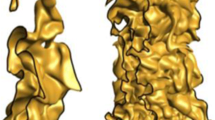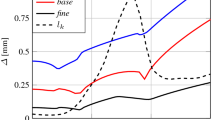Abstract
Numerical simulation results are presented for three turbulent jet diffusion flames, stabilized behind a bluff body (Sydney Flames HM1-3). Interaction between turbulence and combustion is modeled with the transported joint-scalar PDF approach. The focus of the study is on the impact of the quality of simulation results in physical space on the behavior of two micro-mixing models in composition space: the Euclidean Minimum Spanning Tree (‘EMST’) model and the modified Curl coalescence dispersion (‘CD’) model. Profiles of conditional means and variances of thermo-chemical quantities, conditioned on the mixture fraction, are discussed in the recirculation region and in the neck zone behind. The impact of the flow and mixing fields in physical space on the mixing model behavior in composition space is strong for the CD model and increases as the turbulence – chemistry interaction becomes stronger. The EMST conditional profiles, on the contrary, are hardly affected.
Similar content being viewed by others
Abbreviations
- CD:
-
coalescence/dispersion
- \( C_{\theta } \) :
-
micro-mixing model constant
- D b :
-
bluff body diameter (m)
- EMST:
-
Euclidean Minimum Spanning Tree
- F :
-
probability density function
- F :
-
mass density function
- IP:
-
isotropization of production
- ISAT:
-
in situ adaptive tabulation
- J ik :
-
diffusive flux of species k in direction i (kg/(m2s))
- K :
-
turbulent kinetic energy (m2/s2)
- LRR:
-
Launder–Reece–Rodi
- NL:
-
non-linear
- PDF:
-
probability density function
- R :
-
radial distance (m)
- R b :
-
bluff body radius (m)
- SM:
-
Reynolds stress model
- S k :
-
chemical source term for species k (kg/s)
- Sc t :
-
turbulent Schmidt number (–)
- T :
-
temperature (K)
- TR:
-
time scale ratio (–)
- U I :
-
mean velocity component (m/s)
- x I :
-
coordinate direction
- X :
-
axial coordinate (m)
- Y :
-
species mass fraction (–)
- Γ t :
-
turbulent diffusivity (Pa s)
- ɛ :
-
turbulent dissipation rate (m2/s3)
- μ t :
-
turbulent viscosity
- ρ :
-
density (kg/m3)
- ψ :
-
composition space sample variable (–)
- ξ :
-
mixture fraction (–)
References
Pope, S.B.: Prog. Energy Combust. Sci. 11, 119–192 (1985)
Dally, B.B., Masri, A.R., Barlow, R.S., Fiechtner, G.J., Fletcher, D.F.: Combust. Flame 114, 119–148 (1998)
Dally, B.B., Fletcher, D.F., Masri, A.R.: Combust. Theory Model 2, 193–219 (1998)
Janicka, J., Kolbe, W, Kollman, W: J. Non-Equil. Thermodyn. 4, 47–66 (1979)
Subramaniam, S., Pope, S.B: Combust. Flame 115, 487–514 (1998)
Subramaniam, S, Pope, S.B.: Combust. Flame 117(4), 732–754 (1999)
Liu, K., Pope, S.B., Caughey, D.A.: Combust. Flame 141(1–2), 89–117 (2005)
Mitaria, S., Riley, J.J., Kosály, G.: Phys. Fluids 17(047101), 1–15 (2005)
Ren, Z.Y., Pope, S.B.: Combust. Flame 136(1–2), 208–216 (2204)
Cao, R.R., Pope, S.B.: Combust. Flame 143, 450–470 (2005)
Merci, B., Roekaerts, D., Naud, B.: Combust. Flame 144(3), 476–493 (2006)
Merci, B., Roekaerts, D., Naud, B., Pope, S.B.: Combust. Flame 146(1–2), 109–130 (2006)
Li, G., Naud, B., Roekaerts, D.: Flow Turbul. Combust. 70(1–4), 211–240 (2003)
Merci, B., Dick, E.: Int. J. Heat Mass Transfer 46(3), 469–480 (2003)
Smooke, M.D., Giovangigli, V.: Lect. Notes Physics 384, 1–47 (1991)
Hossain, M., Jones, J.C., Malalasekera, W.: Flow Turbul. Combust. 67(3) 217–234 (2001)
Pope, S.B.: Combust. Theory Model. 1, 41–63 (1997)
Launder, B.E., Reece, G.J., Rodi, W.: J. Fluid Mech. 68, 537–566 (1975)
Merci, B., Vierendeels, J., Dick, E., Roekaerts, D., Peeters, T.W.J.: Combust. Flame 126(1–2), 1533–1556 (2001)
Merci, B., Dick, E., De Langhe, C.: Combust. Flame 131(4) 465–468 (2002)
Fox, R.O.: Computational Models for Turbulent Reacting Flows, Cambridge University Press, Cambridge, UK (2003).
Bilger, R.W., Starner, S.H., Kee, R.J.: Combust. Flame 80, 135–149 (1990)
Author information
Authors and Affiliations
Corresponding author
Rights and permissions
About this article
Cite this article
Merci, B., Naud, B. & Roekaerts, D. Impact of Turbulent Flow and Mean Mixture Fraction Results on Mixing Model Behavior in Transported Scalar PDF Simulations of Turbulent Non-premixed Bluff Body Flames. Flow Turbulence Combust 79, 41–53 (2007). https://doi.org/10.1007/s10494-006-9063-1
Received:
Accepted:
Published:
Issue Date:
DOI: https://doi.org/10.1007/s10494-006-9063-1




